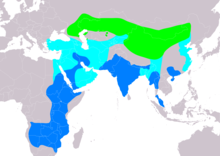This article may be too long to read and navigate comfortably. (November 2023) |
| Steppe eagle | |
|---|---|

| |
| Individual at Jorbeer, Bikaner, Rajasthan | |
| Scientific classification | |
| Domain: | Eukaryota |
| Kingdom: | Animalia |
| Phylum: | Chordata |
| Class: | Aves |
| Order: | Accipitriformes |
| Family: | Accipitridae |
| Genus: | Aquila |
| Species: | A. nipalensis
|
| Binomial name | |
| Aquila nipalensis Hodgson, 1833
| |
| Subspecies[2] | |
| |

| |
| Range of A. nipalensis Breeding Passage Non-breeding
| |
| Synonyms | |
|
Aquila rapax nipalensis | |
The steppe eagle (Aquila nipalensis) is a large bird of prey. Like all eagles, it belongs to the family Accipitridae.[4] The steppe eagle's well-feathered legs illustrate it to be a member of the subfamily Aquilinae, also known as the "booted eagles".[5] This species was once considered to be closely related to the sedentary tawny eagle (Aquila rapax) and the two forms have previously been treated as conspecific. They were split based on pronounced differences in morphology and anatomy;[6][7] two molecular studies, each based on a very small number of genes, indicate that the species are distinct but disagree over how closely related they are.[7][8][9]
The steppe eagle is in many ways a peculiar species of eagle. It is a specialized predator of ground squirrels on the breeding ground, also taking other rather small mammals and other prey, doing so more often when ground squirrels are less consistently found.[10] In rather treeless areas of the steppe habitats, these eagles tend to nest on a slight rise, often on or near an outcrop, but may even be found on flat, wide-open ground, in a rather flat nest. They are the only eagle to nest primarily on the ground.[11] Usually one to three eggs are laid and, in successful nests, one to two young eagles fledge.[12] The steppe eagle undertakes a massive migration from essentially its entire breeding range, moving en masse past major migration flyways, especially those of the Middle East, Red Sea and the Himalayas.[4] In winter, though less closely studied than during breeding, the steppe eagle is remarkable for its sluggish and almost passive feeding ecology, focusing on insect swarms, landfills, carrion and the semi-altricial young of assorted animals, lacking the bold and predatory demeanor of their cousin species.[13][14] Although still seen by the thousands at migration sites in larger numbers than other migrating eagles of these areas, the steppe eagle's entire population has declined precipitously.[15] The threats to this species consist of increasing steppe fires and pests around the nests (both probably increased by the warming climate) which can cause a large volume of nest failures. Rivaling these factors, declines are being exacerbated by disturbance and persecution by humans, as well trampling of nests by livestock. Free-flying steppe eagles are also being killed in alarmingly large numbers, especially in the stronghold nation for breeding of Kazakhstan, by electrocutions on dangerous electricial wires and pylons.[1][16] Due to these and other reasons, the decline of the species is thought to be considerably in excess of 50%. Therefore, the species is considered to be endangered by the IUCN.[1] The steppe eagle appears on the flag of Kazakhstan and is the national bird of both Kazakhstan and Egypt.
- ^ a b c BirdLife International (2020). "Aquila nipalensis". IUCN Red List of Threatened Species. 2020: e.T22696038A180479129. doi:10.2305/IUCN.UK.2020-3.RLTS.T22696038A180479129.en. Retrieved 13 November 2021.
- ^ Gill F, D Donsker & P Rasmussen (Eds). 2020. IOC World Bird List (v10.2). doi : 10.14344/IOC.ML.10.2.
- ^ В. П. Белик; В. М. Галушин (2019). "ИСТОРИЯ ФОРМИРОВАНИЯ НАУЧНОЙ НОМЕНКЛАТУРЫ И ВАЛИДНОСТЬ СОВРЕМЕННЫХ ИМЕН НЕКОТОРЫХ ВИДОВ ОРЛОВ РОДА AQUILA (ACCIPITRIDAE)". Зоологический Журнал (in Russian). 98 (1): 79–88. doi:10.1134/S0044513418070036. S2CID 91202295.
- ^ a b Ferguson-Lees, J.; Christie, D. (2001). Raptors of the World. Houghton Mifflin Harcourt. ISBN 0-618-12762-3.
- ^ Helbig, A. J., Kocum, A., Seibold, I., & Braun, M. J. (2005). A multi-gene phylogeny of aquiline eagles (Aves: Accipitriformes) reveals extensive paraphyly at the genus level. Molecular phylogenetics and evolution, 35(1), 147–164.
- ^ Clark, W.S. (1992). "The taxonomy of Steppe and Tawny Eagles, with criteria for separation of museum specimens and live eagles". Bulletin of the British Ornithologists' Club. 112: 150–157.
- ^ a b Olson, Storrs L. (1994). "Cranial osteology of Tawny and Steppe Eagles Aquila rapax and A. nipalensis". Bulletin of the British Ornithologists' Club. 114: 264–267.
- ^ Cite error: The named reference
globalraptorswas invoked but never defined (see the help page). - ^ Sangster, George; Knox, Alan G.; Helbig, Andreas J.; Parkin, David T. (2002). "Taxonomic recommendations for European birds". Ibis. 144 (1): 153–159. doi:10.1046/j.0019-1019.2001.00026.x.
- ^ Vazhov, S. V., Bachtin, R. F., Barashkova, A. N., & Smelansky, I. E. (2013). On the Study of the Steppe Eagle in the Altai Kray, Russia. Raptors Conservation, (27).
- ^ Brown, L. & Amadon, D. (1986) Eagles, Hawks and Falcons of the World. The Wellfleet Press. ISBN 978-1555214722.
- ^ Karyakin, I. V., Kovalenko, A. V., Levin, A. S., & Pazhenkov, A. S. (2011). Eagles of the Aral-Caspian Region, Kazakhstan. Raptors Conservation, (22).
- ^ Steyn, P. (1983). Birds of prey of southern Africa: Their identification and life histories. Croom Helm, Beckenham (UK). 1983.
- ^ Naoroji, R., & Schmitt, N. J. (2007). Birds of prey of the Indian subcontinent. Om Books International.
- ^ Weiss, N., Haviv, E., Alon, D., Perlman, Y., & Schäckermann, J. (2019). How Fast Does the Steppe Eagle Population Decline? Survey Results from Eilat, Israel. Raptors Conservation, 38.
- ^ Karyakin, I.V. (2018). The status of the steppe eagle in the world: "white spots" in distribution, abundance, ecology and threats. Raptor Research , (S1).
